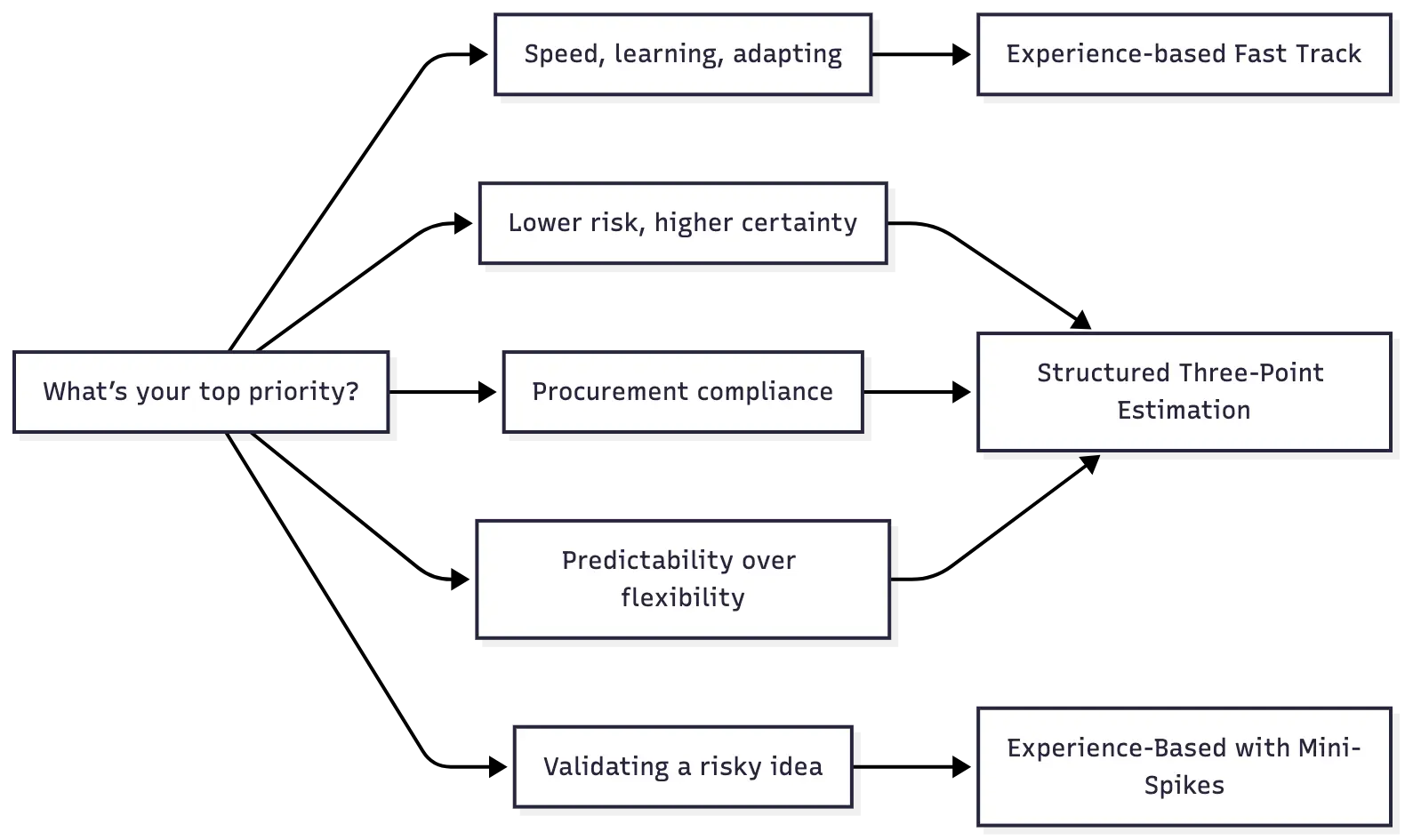How Do Software Estimates Really Work, And How Can You Tell If Yours Is Any Good?
25.11.2025 | 4 min read

There are two valid ways to estimate software projects when you’re not joining an existing team:
1. fast, flexible, experience-based estimates for innovation projects, and
2. detailed three-point estimates for enterprise or fixed-price needs.
A good estimate clearly states assumptions, maps work to business outcomes, and shows where risk lives. If your proposal doesn’t do these things, it’s not an estimate. It’s an optimistic wish list.

Every founder, product owner, and CTO eventually asks the same question:
How much will it cost, and how long will it take?
You receive a spreadsheet, a timeline, maybe even some story points. Fast-forward a few months, and suddenly the numbers no longer connect to reality. Where did the estimate come from? And why is it already drifting?
At 10Clouds, we’ve been on every side: as a client, as a delivery partner, and as the people explaining why a “3-month project” is somehow now closer to five. We analyzed 50+ delivery projects over the last 5 years. 84% launched within 20% of estimated timelines when the correct estimation approach was applied.
This is how we know what works and what doesn’t.
This guide breaks down how software estimates are actually built, when each type makes sense, and how to evaluate whether the estimate in front of you is grounded in reality.
Which context does your software estimate fit into?
Software estimates usually fall into one of three worlds:
1) Existing in-house or long-term agile teams
Work is continuous, velocity is known, estimation relies on real data. We won’t cover this here. Predictability is comparatively high.
2) New products with high uncertainty
Startups, first releases, and new ideas.
Goal: launch something meaningful in 3–6 months.
Reality: nobody fully knows what “something” is yet.
3) Enterprise or mature-product delivery
RFPs, integrations, compliance, procurement.
Requirements are clearer but complexity is real.
And it’s these last two where estimation becomes both exciting and risky.
Because in both cases… we’re not joining an existing team but building one. Every assumption, role, and hour matters here.
What estimation strategies actually work in software delivery?
Depending on your certainty level and business constraints, we use one of the following.
1) When should you use a fast-track, experience-based estimate?
Best for: startups and innovation projects
Goal: speed and learning
We assemble a tight team (design, FE, BE, QA, Delivery) and build a lean delivery plan based on similar launches we’ve delivered.
We don’t list every dependency. We accept uncertainty from day one. We optimize for iteration, not paperwork.
Pros
- Fast to start
- Flexible to change
- Perfect for product discovery
Cons
- Variance of 25–50 percent is normal
- Needs tight alignment on evolving priorities
Output
- High-level timeline
- Team plan
- Tangible business goal such as:
“Live marketplace in 4 months”
Example call-out: In our work with Altruisto we opted for this approach — uncertainty over target demographics and revenue model required fast feedback loops and pivot readiness.
Takeaway: Great for finding product-market fit. Not ideal for procurement officers who need fixed everything.
2) When do you need structured three-point estimation?
Best for: enterprise delivery, fixed-price requirements
Goal: confidence and risk management
Here, we estimate every epic, story, and milestone collaboratively with the team:
- Break down functionality into user stories
- Define clear assumptions (included, excluded, dependencies)
- Apply three-point estimate per story:
- Optimistic (O)
- Most likely (ML)
- Pessimistic (P)
- Convert effort to timeline and resource plan
- Add buffers for management, communication, and QA
This makes uncertainty visible early, so we know where to run spikes or clarify details.
Pros
- Transparent, detailed, supports fixed-price
- Shared understanding between business and engineering
Cons
- Takes more time before starting delivery
Output
- Estimation report with costs and timeline
- Risk hotspots clearly marked
- Assumptions documented upfront
Example call-out: For our project with Crescent (finance app) we delivered a structured estimate because architecture, integrations and compliance required clarity from day one.
Takeaway: When accuracy matters more than speed, detail is your friend.
How do you choose the right estimation method for your project?
Here’s your due-diligence checklist:
✓ Assumptions are written, not implied
✓ Clear breakdown by role (FE, BE, QA, design, DevOps)
✓ Risks and unknowns identified, not hidden
✓ Business outcomes defined, not just backlog items
✓ Timeline and cost tied to real effort
✓ Buffering is explicit, not magic-number padding
✓ You understand how scope change impacts cost
✓ Team composition and availability included
✓ There’s a plan for decision-making, not just delivery
If any of these are missing… you don’t really have a plan but a projection.
How do you evaluate whether an estimate is realistic?
Quick Decision Guide

Takeaway: Choose the estimation method that matches the risk tolerance of your business — not your ideal scenario.
FAQs
What’s the main reason software estimates go wrong?
Unstated assumptions. Surprises aren’t surprises but omissions.
Which is more accurate: Agile velocity or story point estimates?
Velocity based on real team data. Story points without historical throughput is guesswork.
How much variance should I expect?
For new builds: 25–50 percent.
For mature enterprise delivery: 10–25 percent.
Is fixed price always safer?
Only if the scope is genuinely fixed. Otherwise, you pay for change requests instead of progress.
When should I pay for discovery?
When the unknowns outnumber the knowns. Discovery buys certainty.
What’s the one truth to remember about estimates?
The most accurate estimate isn’t the one that lists all features.
It’s the one that exposes uncertainty, measures it, and plans around it.
If you’d like us to assess your current estimate and highlight:
- Hidden assumptions
- Technical risk areas
- Cost-uncertainty hotspots
Send us your estimate. We’ll turn guesswork into grounded planning.
Sources
- InfoQ, “What We Do and Don’t Know about Software Development Effort Estimation”
- ResearchGate, “The Impact of IT Projects Complexity on Cost Overruns and Schedule Delays”



